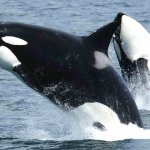
Europe’s killer whales wowed in the BBC’s Blue Planet II series but these animals face extinction. It was one of those television moments. The sight of killer whales herding shoals of herring into tighter and tighter balls to trap the prey near the surface of the water. The killer whales work as a pack of skilful hunters before deploying their secret weapon – tail-slapping the fish so hard they are either dazed or die. The story behind those shots is even more remarkable.
They were filmed in the majestic Norwegian fjords. These long, narrow inlets are now among the few places in Europe you can see a pod of killer whales.
Across Europe, these cetaceans are declining rapidly.
In the Mediterranean and the North Sea, they have vanished.
Elsewhere, there are now only eight killer whales in the NW Scotland-Ireland population, and only 36 left in the Strait of Gibraltar population.
Scientists believe they are doomed to extinction due to harmful chemicals manufactured by man.
This worrying decline explains why tourists and marine biologists are flocking to the fjords around Kvaløya – which aptly translates as Whale Island.
Kvaløya is nestled in the Arctic Circle, close to the city of Tromsø.
It is the land of the Northern Lights, of snow-capped mountains and weak winter sun. It is also the land of observing something spectacular.
It’s here that a humpback whale announces its presence with a thunderous blast of water through its blowhole – a sound like the opening of the woodwind section of an orchestra.
Shortly afterwards, a pod of killer whales arrives on the scene. The orcas glide with grace through the icy water.
Marcus Åhlund is a tour guide who spends several hours at sea on his boat every day and often in freezing temperatures.
Hearteningly, he is still so visibly excited by seeing the pod.
Marcus lives on Kvaløya and tells me with a huge smile on his face that the numbers of killer whales here are actually on the rise. But he knows the cherished photographs of his passengers and these lasting memories shouldn’t be taken for granted.
“We thought we lost them,” he said. “The island is named after the whales because they were always found here. But for 70 years, the whales abandoned the island. It’s only in the last five years that they’ve been coming back.”
The return of the killer whales after so many years left locals and scientists scratching their heads. It didn’t make sense when the rest of Europe’s killer whale population was dying off.
Fredrik Broms, a local marine biologist and keen photographer, believes the answer is simple. Food.
The killer whales are just following their lunch like a human at a drive-through restaurant – the enormous shoals of herring.
“This is one of nature’s largest feeding frenzies. The herring changed their route. They have started to come back here and so the whales follow,” he said.
Scientists believe these Norwegian orcas are faring much better than their cousins in the south because of their diet.
In Kvaløya and across northern Norway, the whales gorge themselves almost entirely on herring. These smaller fish feed on plankton and are therefore less exposed to a toxic group of chemicals known as PCBs (polychlorinated biphenyls).
However, in the Mediterranean and around UK shores, killer whales eat large fish that are already higher up the food chain and therefore carry a larger load of PCBs.
These harmful chemicals were once used in electrical gear, paints and flame retardants. They were used heavily in the construction of tower blocks but were banned from the 1970s because of their toxic effect in humans and animals.
However, the manmade chemicals have leached into the sea, and are accumulating in top predators.















Social Profiles